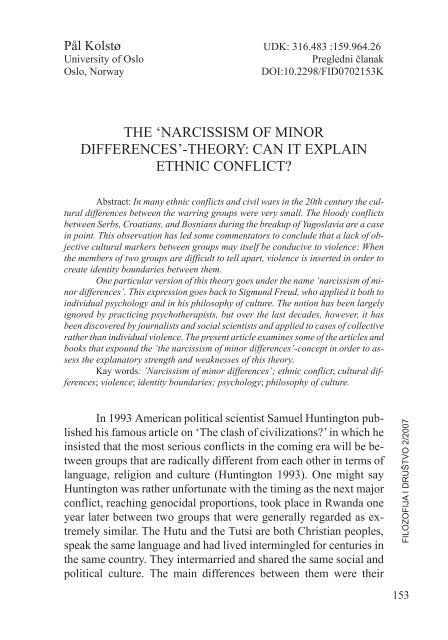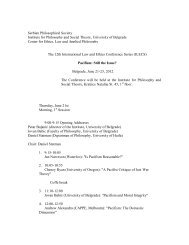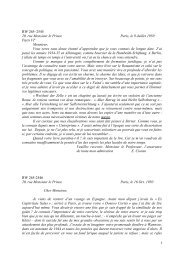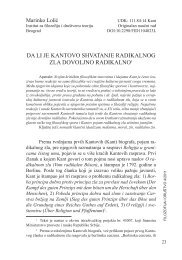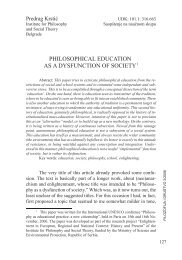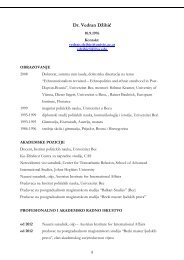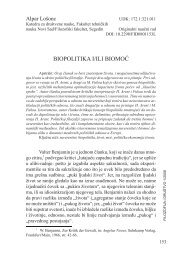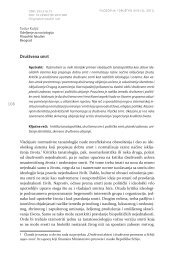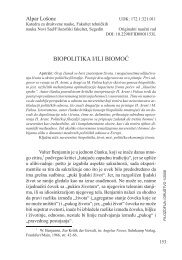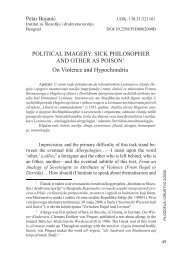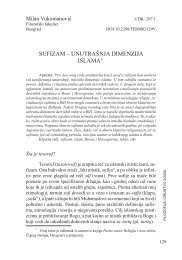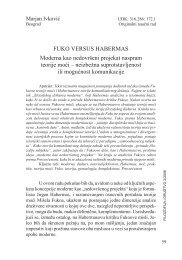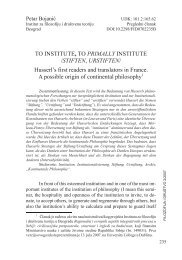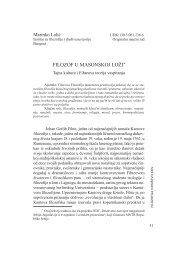THE 'NARCISSISM OF MINOR DIFFERENCES ... - DOI Serbia
THE 'NARCISSISM OF MINOR DIFFERENCES ... - DOI Serbia
THE 'NARCISSISM OF MINOR DIFFERENCES ... - DOI Serbia
You also want an ePaper? Increase the reach of your titles
YUMPU automatically turns print PDFs into web optimized ePapers that Google loves.
Pål Kolstø UDK: 316.483 :159.964.26<br />
University of Oslo Pregledni èlanak<br />
Oslo, Norway <strong>DOI</strong>:10.2298/FID0702153K<br />
<strong>THE</strong> ‘NARCISSISM <strong>OF</strong> <strong>MINOR</strong><br />
<strong>DIFFERENCES</strong>’-<strong>THE</strong>ORY: CAN IT EXPLAIN<br />
ETHNIC CONFLICT?<br />
Abstract: In many ethnic conflicts and civil wars in the 20th century the cultural<br />
differences between the warring groups were very small. The bloody conflicts<br />
between Serbs, Croatians, and Bosnians during the breakup of Yugoslavia are a case<br />
in point. This observation has led some commentators to conclude that a lack of objective<br />
cultural markers between groups may itself be conducive to violence: When<br />
the members of two groups are difficult to tell apart, violence is inserted in order to<br />
create identity boundaries between them.<br />
One particular version of this theory goes under the name ‘narcissism of minor<br />
differences’. This expression goes back to Sigmund Freud, who applied it both to<br />
individual psychology and in his philosophy of culture. The notion has been largely<br />
ignored by practicing psychotherapists, but over the last decades, however, it has<br />
been discovered by journalists and social scientists and applied to cases of collective<br />
rather than individual violence. The present article examines some of the articles and<br />
books that expound the ‘the narcissism of minor differences’-concept in order to assess<br />
the explanatory strength and weaknesses of this theory.<br />
Kay words: ’Narcissism of minor differences’; ethnic conflict; cultural differences;<br />
violence; identity boundaries; psychology; philosophy of culture.<br />
In 1993 American political scientist Samuel Huntington published<br />
his famous article on ‘The clash of civilizations?’ in which he<br />
insisted that the most serious conflicts in the coming era will be between<br />
groups that are radically different from each other in terms of<br />
language, religion and culture (Huntington 1993). One might say<br />
Huntington was rather unfortunate with the timing as the next major<br />
conflict, reaching genocidal proportions, took place in Rwanda one<br />
year later between two groups that were generally regarded as extremely<br />
similar. The Hutu and the Tutsi are both Christian peoples,<br />
speak the same language and had lived intermingled for centuries in<br />
the same country. They intermarried and shared the same social and<br />
political culture. The main differences between them were their<br />
FILOZ<strong>OF</strong>IJA I DRUŠTVO 2/2007<br />
153
PÅL KOLSTØ<br />
154<br />
body height and traditional economy – agriculture vs. livestock<br />
breeding. Based on these differences their colonial masters in the<br />
early 20 th century separated them into two distinct ethnic groups<br />
(Gourevitch 1998: 47-55; Mann 2005: 432-34), but often it was impossible<br />
to tell a Hutu from a Tutsi by their appearance, you had to<br />
know who was what.<br />
If Huntington’s theory was wrong, perhaps the opposite claim<br />
is correct? In other words, a high degree of similarities between two<br />
groups predisposes them for conflict? For instance, the violent conflicts<br />
in the former Yugoslavia — the most massive killings in Europe<br />
since World War II — pitted against each other peoples that shared a<br />
lot of common cultural traits (Wachtel 1998). To be sure, Samuel<br />
Huntington would interpret this as a case of civilizational clash since<br />
the Serbs, the Croats, and the Bosnians adhere to three different religions.<br />
Indeed they do, but this fact can easily be misinterpreted. In the<br />
communist period, Yugoslavia had undergone considerable secularization,<br />
and for most Yugoslavs religious affiliation did not indicate<br />
which house of worship they themselves went to, but rather which religion<br />
their parents or grandparents had practiced. Moreover, the<br />
Serbs, Croats, and Bosnians spoke the same language, looked alike,<br />
dressed alike, watched the same movies, listened to the same music,<br />
and basically ate the same food. To be sure, some dishes were regarded<br />
as ‘traditionally Bosnian’ or ‘typically <strong>Serbia</strong>n’, but members<br />
of all groups could well relish the food of all the other nations.<br />
If one starts to look for cases of genocide and other forms of<br />
extreme violence involving groups with virtually the same cultural<br />
background, phenotypical similarities, and identical language, it is<br />
surprising how much one can come up with. Let me remind you of<br />
just a few. It has often been commented that Somalia is one of the few<br />
— if not the only — African country whose population is monoethnic,<br />
but this did not prevent it from descending into an inferno of internecine<br />
killings in the 1990s. Furthermore, no-one would characterize<br />
the civil wars in Zaire/Congo in the 1990s – involving millions<br />
of deaths – as a case of civilizational clash. There were no doubt tribal<br />
differences among the warring parties in the Congolese wars, but<br />
these differences did not straddle any racial or religious barrier.<br />
In fact, one might include even the Nazi attempt to exterminate<br />
the Jewish race on this list of genocides where the victims were
very similar to the perpetrators. To be sure, the Holocaust involved a<br />
clear-cut case of religious differences – Gentiles vs. Jews and most of<br />
the East European Jews exterminated by the Nazis had a lifestyle and<br />
culture very different from their executioners. Even so, it was the Nazis’<br />
encounter with highly urbanized and assimilated Jews in Germany<br />
and Austria that imbued them with their determination to kill as<br />
many Jews as possible. These German-speaking Jews often went to<br />
extreme lengths to adopt to the cultural practices of their ‘indigenous’<br />
German neighbors. Many even brought a pine tree adorned with candle<br />
lights and colored glass balls into their living rooms during Hanukkah,<br />
or ‘Weihnukkah’, as it was sometimes derisively called.<br />
Moreover, their German was so impeccable that, as was the case with<br />
the Hutus and the Tutsis, it would have been impossible to use ‘the<br />
Shibboleth criterion’ to distinguish them from their German neighbours.<br />
They would love Goethe and Schiller just as much as they<br />
loved Heine, and probably prefer Beethoven to Mendelssohn.<br />
Can we from these observations extract a general theory of<br />
cultural closeness leading to hostility and conflict between similar<br />
groups? Intrigued by this question I started to look for traces of such<br />
theories and came across the concept of ‘narcissism of minor differences’<br />
(or NMD for short). As one might expect, it emanates from<br />
the writings of Sigmund Freud who returned to it on three different<br />
occasions, each time adding a new dimension to it. The concept originally<br />
stemmed from his observations of clients during psychotherapy,<br />
and hence referred to individual psychological disorder. Later<br />
Freud employed it also in his cultural analysis of European civilization<br />
and applied it to relations between ethnic and national groups.<br />
According to Alvin Burstein the paradoxical claim that internecine<br />
conflict is especially related to small differences is not only<br />
broadly accepted, but often presented as an indisputable given.<br />
(Burstein 1999: 1) Some scholars who refer to the ‘narcissism of minor<br />
differences’-concept do so without further commentary as if the<br />
term were self-explanatory (and sometimes use it quite out of context,<br />
see e.g. Horowitz and Matthews 1997). A few authors, however,<br />
have discussed the concept in some depth, and some make<br />
rather strong assertions on behalf of it. David Werman (1998: 457)<br />
for instance, claims that ‘the narcissism of minor differences has a<br />
malignant potential to erupt in vast bloodbaths which have even<br />
FILOZ<strong>OF</strong>IJA I DRUŠTVO 2/2007<br />
155
PÅL KOLSTØ<br />
156<br />
reached the level of genocide’. Watts (2001: 90) maintains that ‘the<br />
narcissistic construal of minor as major […] is so often attached to<br />
what one might call a “drive to extinction” by a compelling need to<br />
eliminate and extinguish the other’. Watts uses this theory to explain<br />
excessive state reactions to local conflicts in Nigeria. More articles<br />
that employ this theory will be presented below. But let us first turn<br />
to the origin of the concept and see what Freud himself had to say on<br />
the matter.<br />
Freud’ concept of narcissism of minor difference<br />
In Greek mythology, as will be recalled, Narcissus was a vain<br />
and beautiful hero whom the goddess Nemesis condemned to fall in<br />
love with his own image as reflected in a pond. Freud therefore used<br />
the term ‘narcissism’ as an expression of morbid self-love. By ‘Narcissism<br />
of minor difference’¸ then, Freud originally meant a special<br />
kind a morbid self-love that builds upon an exaggerated notion of<br />
how the person differs from people around him/her. When he applied<br />
it also to relations among groups, the term suggested that group<br />
members embrace their group with an excessive love because they<br />
see it as radically different from other groups, a claim that an outside<br />
observer would regard as spurious.<br />
Freud first used the term ‘narcissism of minor difference’ in<br />
The Taboo of Virginity (1917). Here he built on an idea he allegedly<br />
had found in the writings of the British anthropologist Ernest<br />
Crawley:<br />
Crawley, in language which differs only slightly from the current<br />
terminology of psycho-analysis, declares that each individual<br />
is separated from others by a ‘taboo of personal isolation’,<br />
and that it is precisely the minor differences in people<br />
who are otherwise alike that form the basis of feelings of<br />
strangeness and hostility between them. It would be tempting<br />
to pursue this idea and to derive from this ‘narcissism of minor<br />
differences’ the hostility which in every human relationship<br />
we see fighting successfully against feelings of fellowship<br />
and overpowering the commandment that all men should<br />
love one another.(Freud 1917:199)
Burstein (1999:2) points out that Freud misquoted Crawley<br />
who had maintained that not only minor differences but all differences<br />
are problematic. In order to find the roots of the NMD idea,<br />
therefore, we don’t have to go back to Crawley, but may stop at Freud.<br />
In Group Psychology and the Analysis of the Ego (1921) Freud<br />
developed this concept somewhat further and applied it to attitudes<br />
between nations and between regional groups within nations. ‘Closely<br />
related races keep one another at arm’s length; the South German<br />
can not endure the North German, the Englishman casts every kind of<br />
aspersion on the Scot, the Spaniard despises the Portuguese.’ However,<br />
in this book Freud did not claim that minor differences are more<br />
prone to lead to animosity and conflict than big ones. On the contrary,<br />
he immediately went on to suggest that greater differences may cause<br />
even greater hostility among groups: ‘We are no longer astonished<br />
that greater differences should lead to almost insuperable repugnance,<br />
such as the Gallic people feel for the German, the Aryan for the<br />
Semite, and the white races for the colored.’ (Freud 1921: 101)<br />
The third and last time Freud referred to the term ‘narcissism<br />
of minor difference’ is in his controversial but highly influential<br />
book Civilization and its Discontents. Here he stated that<br />
It is always possible to bind together a considerable number<br />
of people in love, so long as there are other people left over to<br />
receive the manifestations of their aggressiveness. I once discussed<br />
the phenomenon that it is precisely communities with<br />
adjoining territories, and related to each other as well, that are<br />
engaged in constant feuds and in ridiculing each other—like<br />
the Spaniards and the Portuguese, for instance, the North Germans<br />
and the South Germans, the English and the Scots and<br />
so on. I gave this phenomenon the name of the ‘narcissism of<br />
minor differences’a name that does not do much to explain it.<br />
We can now see that it is a convenient and relatively harmless<br />
satisfaction of the inclination to aggression, by means of<br />
which cohesion between the members of the community is<br />
made easier. (Freud 1930: 114)<br />
Here Freud clearly shows the main sociological function of<br />
NMD as he sees it: it increases cohesion within the group by directing<br />
aggression towards outsiders.<br />
FILOZ<strong>OF</strong>IJA I DRUŠTVO 2/2007<br />
157
PÅL KOLSTØ<br />
158<br />
Civilization and its Discontents is based on a most pessimistic<br />
perception of human nature. Man is inherently an asocial and aggressive<br />
animal, and the purpose of civilization (or ‘Kultur’as Freud<br />
called it in German) is to tame our aggressive inclinations and enable<br />
us to ‘live and let live’ rather than annihilate each other. The instinct<br />
of aggression cannot be entirely extinguished, but the remnants of it<br />
that civilization is unable to suppress, may be directed towards human<br />
beings beyond the pale. In that way aggression is prevented<br />
from tearing the group apart. As an example of how this is done,<br />
Freud sardonically remarked that the Jews throughout history ‘have<br />
rendered most useful services to the civilizations of the countries<br />
that have been their hosts’ (ibid.).<br />
The above quotations represents the entire corpus of Freud’s<br />
writings on NMD. The idea was never developed into a full-fledged<br />
theory, but remained a few scattered and isolated remarks that left a<br />
number of questions unanswered. For instance, on what level in<br />
Freud’s three-storey structure of man’s psyche did he believe that<br />
these socio-psychological processes take place: on the level of the<br />
subconscious, the consciousness, or in the super-ego? And just as<br />
importantly, did he believe that minor differences are able to cause<br />
animosity and conflicts, or is it only a case of ex post rationalization<br />
of hostility that exists prior to and independent of differences between<br />
individuals and groups? Werman (1988: 452) believes that<br />
latter, but how should we then interpret Freud’s remark that ‘We are<br />
no longer astonished that greater differences should lead to almost<br />
insuperable repugnance’ (emphasis added)? And finally, if Freud<br />
believed that both big and small differences are related to group formation,<br />
wherein lies the specificity of the ‘narcissism of minor<br />
differences’?<br />
Civilization and its Discontents was written only three years<br />
before Hitler’s rise to power and eight years before Freud had to flee<br />
from Germany. To the extent that Freud really saw NMD — including<br />
the Europeans’ treatment of the Jews — as a ‘relatively harmless<br />
satisfaction of the inclination to aggression’, we might be allowed to<br />
see the publication of his book as just as badly timed as Huntington’s<br />
article. Be that as it may, most later commentators seem to assume<br />
that Freud had stumbled across a socio-psychological mechanism<br />
that was more powerful than he himself suspected.
Modern usages of the NMD idea<br />
Those who have written about NMD fall roughly into two<br />
professional categories: psychoanalysts and social scientists. The<br />
contributions of the first group dominated until around 1990-92, that<br />
is, until the outbreak of the wars of Yugoslav succession, when sociologists,<br />
social anthropologists, and political scientists took over.<br />
With their intimate knowledge of Freudianism the psychoanalysts<br />
will presumably be best placed to give a correct exegesis of the<br />
Freudian scriptures, while the social scientists might have a better<br />
insight into the dynamics of ethnic conflicts. Ideally, they may complement<br />
each other.<br />
Psychiatrist David Werman notes that practitioners of psychoanalysis<br />
have paid relatively little attention to the notion of<br />
NMD, in spite of the fact that this phenomenon, he claims, may be<br />
observed almost daily in all walks of life. As an example he mentions<br />
an episode from his own practice as a psychoanalyst. A middle-aged<br />
professor of the humanities entered psychoanalysis due to,<br />
inter alia, difficulties in relations with his colleagues. ‘Dr. M described<br />
a heated discussion he had had with one of his colleagues. It<br />
was evident that the initial disagreement was not of great importance,<br />
but … Dr. M. was not in the least aware of the triviality of the<br />
original argument.’ (Werman, 1998: 456) Werman concluded that<br />
the patient suffered from a narcissism of minor differences.<br />
One can easily sympathize with the doctor’s frustration as he<br />
had to listen to his patience’s outpourings and lack of understanding<br />
as to what are the really important issues in life. However, most of us<br />
will also no doubt have experienced this situation from the patient’s<br />
side, for instance when we are trying to explain the importance of<br />
our research to an outsider. Sometimes we may be driven to the point<br />
of desperation when a layman not only fails to understand the significance<br />
of our great scientific undertaking, but even begins to question<br />
why society should provide financial support to research that, he<br />
alleges, has no relevance for ‘the real life’. The point to be made<br />
here, then, is simply that what is major and what is minor depends<br />
entirely on the perspective, close up or far away. Surprisingly few<br />
who have written on NMD seem to have taken on board this elementary<br />
insight, most treat ‘minor’ and ‘major’ as absolutes. In the body<br />
FILOZ<strong>OF</strong>IJA I DRUŠTVO 2/2007<br />
159
PÅL KOLSTØ<br />
160<br />
of literature examined in this article only one author (Michael<br />
Ignatieff, see below) acknowledges the relativity of these qualities.<br />
A second psychoanalyst, Vamik Volkan (1986), links Freud’s<br />
concept of NMD to the psychoanalytical theory of externalization,<br />
that is, the unconscious defense mechanism by which individuals<br />
project their own internal characteristics, particularly the bad ones,<br />
onto the outside world and onto other people. When they later come<br />
across a person with these characteristics, they no longer recognize<br />
them as their own. According to Volkan, such externalizations help a<br />
child attain a more cohesive self-representation and more consistent<br />
internalized object representation. ‘When kept inside, unmended<br />
bad units threaten the integrity of the self, but when put “out there” at<br />
a safe distance, and when used for comparison with the good units<br />
kept inside, they enhance the sense of the self. Such “bad” suitable<br />
targets contain the precursors of the concept of an enemy shared by<br />
the group’. (Volkan, 1986: 185; emphasis in the original).<br />
To illustrate this theory, Volkan refers to the conflict between<br />
Greeks and Turks on Cyprus. Greeks and Turks can distinguish each<br />
other at a glance just by noticing such seemingly insignificant details<br />
as different brands of cigarettes: Greeks usually prefer to smoke cigarettes<br />
in blue and white packages – the Greek national colors – while<br />
the Turks smoke cigarettes with their national colors – red and white.<br />
While this observation is somewhat amusing, it seems to me highly<br />
doubtful that such code signaling is what Freud had in mind when he<br />
wrote about NMD. These colors codes do not in any way constitute<br />
the basis for the identity difference between Greeks and Turks but is<br />
only a short-hand way of expressing it. It is no doubt true that the two<br />
island groups have a lot of traditions and customs in common, shared<br />
features that sometimes also differentiate them from their coethnics<br />
on the mainland. At the same time, there are plenty easily observable<br />
differences between Greek Cypriots and Turkish Cypriots with regard<br />
to language and religion, as well as to various cultural codes and<br />
culinary traditions related to religion (Yagcioglu 1996). Therefore,<br />
the islanders do not really have to take resort to cigarette brands to tell<br />
each other apart. We should not confuse ‘minor cultural differences’<br />
with consciously constructed symbols.<br />
If we then move on to the contributions of social scientists to<br />
the NMD debate, we first encounter an article by Turkish political
scientist Türkkaya Ataöv (1998). In a rebuttal to Samuel Huntington<br />
Ataöv points out that in today’s world there are as many, if not more<br />
conflicts within civilizations as there are conflicts between them, for<br />
instance in Northern Ireland, Rwanda, and Pakistan. Ataöv also<br />
notes that ‘the peoples of the newly independent republics of former<br />
Soviet Central Asia are largely Muslim and Turkic. Nevertheless,<br />
there are conflicts among them due to minor differences’ (Ataöv<br />
1998: 5). This is a strong version of the NMD thesis: here Ataöv is<br />
saying that the conflicts in Central Asia have arisen not only in spite<br />
of the similarity between the groups, but due to the minor differences<br />
between them. However, as he develops his thesis further, he reverses<br />
the causal order between conflict and difference:<br />
The interaction of neighbors may be good example. When relations<br />
are pleasant, their desirable parts come to the fore.<br />
When disagreements rise, differences get the upper hand, and<br />
minor differences are then magnified. Even if there are no minor<br />
differences, groups tend to create them. (ibid)<br />
In this example it is clear that the hostility did not stem from<br />
the minor differences, instead, the conflicts are caused by something<br />
else. Members of different groups seize upon the minor differences<br />
in order to expand the identity gap between them and justify their<br />
mutual hostility. The minor differences, then, enter the picture as ex<br />
post rationalizations and not as original impetus. If the differences<br />
between the groups had been major rather than minor they would no<br />
doubt have served the purpose equally well. Ataöv’s argument<br />
leaves the crucial question unanswered: if conflicts do not stem from<br />
(cultural) differences after all, what are they then caused by?<br />
The theoretically most ambitious attempt to elaborate on and<br />
expand Freud’s NMD notion into a full-fledged theory of conflict<br />
has been undertaken by Dutch anthropologist Anton Blok (1998).<br />
Blok makes a double claim: first, minor cultural differences are more<br />
important than major ones. Civil wars, for instance in Russia and the<br />
United States, are usually described as more merciless than other<br />
wars. The conflicts in post-Yugoslavia and Rwanda are cited as other<br />
examples. Second, not only do minor differences underlie a wide<br />
range of conflicts, but also the opposite is true: hierarchy and great<br />
differences make for relative stability and peace.<br />
FILOZ<strong>OF</strong>IJA I DRUŠTVO 2/2007<br />
161
PÅL KOLSTØ<br />
162<br />
Blok, in a sense, is more Freudian than Freud himself. He believes<br />
that when Freud wrote that ‘We are no longer astonished that<br />
greater differences should lead to almost insuperable repugnance’,<br />
the great Austrian doctor came very close to undermining his own<br />
theory. This sentence, Blok thinks, shows that Freud failed to recognize<br />
the importance of his own discovery and reduced its heuristic<br />
value (Blok 1998: 35). Blok even suggests that Freud may have misunderstood<br />
the quintessence of his own discovery, and he volunteers<br />
to rectify this by revealing its true purport.<br />
As it turns out, however, many of the examples Blok cites<br />
clearly show that other factors than NMD, such as status anxiety, economic<br />
interests, and competition for material resources play a greater<br />
role in conflicts than he himself is willing to admit. For instance, he refers<br />
to the Burakumin in Japan, a socially discriminated group that has<br />
sometimes been compared to the untouchables in India. The<br />
Burakumin are ethnically, physiologically, and linguistically indistinguishable<br />
from other Japanese but have historically been treated as<br />
secondary citizens, or worse. They were confined to the most contemptible<br />
professions – butchering and leatherwork – and had to live<br />
in separate quarters. This indeed seems to be a clear-cut case of social<br />
differentiation based on marginal distinctions. The Burakumin were<br />
officially emancipated in 1871 but this did not change the negative attitudes<br />
towards them. On the contrary, ‘local farmers persecuted the<br />
Burakumin for fear of being reduced to the status of these former outcasts’(Blok<br />
1998: 40). Status anxiety, then, is the crux of the matter.<br />
A similar case, also cited by Blok, is anti-Black racism in the<br />
American South after the abolition. The most severe persecution,<br />
Blok points out, came ‘from poor and lower middle class whites…(who)<br />
feared being put on par with the former slaves.’ (ibid.)<br />
Again we see that status anxiety and fear of economic competition<br />
are the decisive factors rather than cultural distance per se. In any<br />
case, the phenotypical differences between poor Whites and poor<br />
Blacks in the United States are so evident that it is highly questionable<br />
whether this distinction may be regarded as ‘minor’.<br />
Blok concludes, quite sensibly, that ‘the narcissism of minor<br />
differences does not automatically result in violence.’(Blok 1998:<br />
49). In addition to demographic and ecological conditions, which<br />
Blok admits will often be very important, he points to the political
context as a critical factor. ‘In all cases where a loss of differences resulted<br />
in extreme violence we find unstable states.’ While Blok, as<br />
we saw, faulted Freud for having emasculated his own idea, he himself<br />
towards the end of his article makes considerably more modest<br />
claims on behalf of NMD than the assertions he started out with.<br />
In an interesting article from 2005 Brett St Louis makes some<br />
of the same observations as Blok: status anxiety and fear of economic<br />
competition are crucially important when minor differences<br />
are socially and politically activated. St Louis discusses conflicts<br />
within the Black population in the United States between ‘native-borns’<br />
and ‘foreign-borns’. She starts by relating a minor episode<br />
from New York in 2004 when an Ethiopian immigrant was told<br />
that he could not benefit from a public health project to educate African<br />
Americans on prostate cancer. The project was part of an Affirmative<br />
Action program in which the concept of ‘African Americans’<br />
was understood to mean ‘descendants of Black slaves’ only. The<br />
Ethiopian immigrant therefore did not qualify. That made him wonder:<br />
if he was not an African American, what was he then?<br />
As it turns out, around 2 million Blacks in the United States<br />
are foreign-born, and together they make up around 5 percent of the<br />
total Black population in the country. In New York city, they constituted<br />
in 2000 no less than 30 percent. It may seem strange that these<br />
immigrants do not identify with native-born Blacks, but in fact many<br />
of them do not. Several hypotheses have been put forward to explain<br />
why this is the case. Black novelist Toni Morrison has argued that<br />
they prefer not to identify racially because they quickly realize that<br />
in the USA blackness is firmly positioned at the bottom of the social<br />
hierarchy (St Louis 2005: 349). But, as the Ethiopian experienced,<br />
dissociation is strong in the other direction, too. Those African immigrants<br />
that might want to embrace blackness have no guarantee<br />
that they will be accepted.<br />
As seen from a non-Black perspective, at least, the squabbles<br />
among American Blacks might seem like a textbook case of identity<br />
differentiation based on very minor distinctions. Brett St Louis believes<br />
that Freud’s notion of NMD ‘provides a useful framework for<br />
understanding the qualitative aspects of this tension between racial<br />
sameness and ethnonational difference’ (St Louis 2005: 347). In her<br />
own approach, however, she relies heavily on an analysis of<br />
FILOZ<strong>OF</strong>IJA I DRUŠTVO 2/2007<br />
163
PÅL KOLSTØ<br />
164<br />
socio-economic competition between these groups that owes little to<br />
Freud’s original idea. The most important explanation for this conflict,<br />
as St Louis sees it, is the fear among native-born Blacks that the<br />
immigrants may eclipse them socially and on the labor market. In the<br />
American Black community there is a widespread perception that<br />
the immigrants are aggressive competitors for social resources and<br />
opportunities. Statistical data show that foreign-born and native-born<br />
Blacks in the USA have very similar income levels, but<br />
due to the greater competitiveness and ambitions of the immigrants<br />
this may well change. It has for instance been pointed out that two<br />
thirds of the Black students at Harvard are either African or Caribbean<br />
immigrants or children of African or Caribbean immigrants.<br />
Brett St Louis, then, concludes that ‘for an analysis of narcissism and<br />
differentiation, it is important to address various motivations such as<br />
fear, failure, defensiveness, protection and affirmation, as well as<br />
material and symbolic processes.’ (St Louis 2005: 348)<br />
The author who has done most to familiarize a modern audience<br />
with the concept of NMD is no doubt Canadian journalist and<br />
war correspondent Michael Ignatieff. Ignatieff has also provided<br />
what in my view amounts to the most sober and balanced assessment<br />
of Freud’s notion. He has, however, presented his ideas in two different<br />
versions, a longer and a shorter one (Ignatieff 1998 and Ignatieff<br />
1999). The former contains a number of caveats and nuances that are<br />
missing in the latter. This longer version is in many ways more defensible<br />
because it tries to defend far less.<br />
An experience four o’clock in the morning in a <strong>Serbia</strong>n command<br />
post in Eastern Slavonia in the <strong>Serbia</strong>n-Croatian war in 1993<br />
prompted Ignatieff to explore the Freudian concept of NMD. He had<br />
observed that it was very difficult to distinguish between a Croatian<br />
and a <strong>Serbia</strong>n by their looks or habits, even for the parties themselves.<br />
The Serbs and Croats drive the same cars; they’ve probably<br />
worked in the same German factories as gastarbeiters; they<br />
long to build exactly the same type of Swiss chalets on the<br />
outskirts of town and raise the same vegetables in the same<br />
back gardens. Modernization – to use a big, ugly word – has<br />
drawn their styles of life together. They have probably more<br />
in common than their peasant grandparents did, especially<br />
since their grandparents were believers.(Ignatieff 1999: 95)
Ignatieff ask a middle aged <strong>Serbia</strong>n reservist in the command<br />
post to explain the difference between a Croat and a Serb. The soldier<br />
first gives a very simple answer, ‘They smoke Croatian cigarettes<br />
while we smoke <strong>Serbia</strong>n ones’. Cigarettes, then, clearly serve<br />
the same function as symbolic boundary marker as on Cyprus. However,<br />
realizing that his answer is somewhat simplistic, the reservist<br />
gives another explanation: ‘Those Croats, they think they’re better<br />
than us. Think they’re fancy Europeans and everything. I’ll tell you<br />
something: We’re all just Balkan rubbish’.(Ignatieff 1999: 91-92)<br />
This answer makes the journalist ponder: Firstly, he concludes<br />
that identity is relational. A Serb defines himself in relation to<br />
Croats and vice versa. Secondly, Ignatieff observes that while globalism<br />
brings us closer together, it also drives us apart. It destroys<br />
boundaries of identities and frontiers between states, and ‘we react<br />
by insisting ever more assiduously on the margins of difference that<br />
remains... The facts of difference themselves are neutral. It is narcissism<br />
that turns difference into a mirror.’(Ignatieff 1999: 96)<br />
Ignatieff formulates the notion of NMD as a paradox: ‘the<br />
smaller the real differences between two groups, the larger such differences<br />
are likely to loom in their imagination.’ This, indeed, is<br />
what most people would normally understand with the phrase ‘narcissism<br />
of minor differences’. However, even as Ignatieff writes this<br />
sentence, he realizes that it is a claim that does not stand up to closer<br />
scrutiny, and hastens to add: ‘my use of terminology is suspect, dubious,<br />
question-begging – major difference/minor difference; objective<br />
versus subjective; real versus imagined; difference as perceived<br />
from within versus difference perceived from without.’ Ignatieff<br />
does not, however, in the shorter article discuss the limitations of his<br />
terminology, but those who consult his longer version, will find the<br />
discussion there.<br />
Here, Ignatieff first tears apart the insight that identity is relational.<br />
To claim that differences are relational, he now concludes, is<br />
an empty tautology. It amounts to saying that we are not what we are<br />
not. Secondly, he attacks the crucial concept of minor-ness: ‘what<br />
looks like a minor difference when seen from the outside may feel<br />
like a major difference when seen from the inside’ (Ignatieff 1998:<br />
50). And indeed, he observes, already Freud himself muddied the<br />
distinction between major and minor. As Ignatieff looks at the matter<br />
FILOZ<strong>OF</strong>IJA I DRUŠTVO 2/2007<br />
165
PÅL KOLSTØ<br />
166<br />
now, he believes that it is a mistake to assume that some human differences<br />
like gender or race are more major than others, for instance<br />
than class or ethnicity. Gender and racial differences are minor relative<br />
to the overwhelming genetic commonality of mankind, but are<br />
major when used as markers of power and status. In this perspective,<br />
power and status rather than culture are foregrounded. ‘No human<br />
difference matters much until it becomes a privilege.’ (ibid.)<br />
What remains, then, of Freud’s original notion? Ignatieff is<br />
not prepared to jettison it completely and insists that it helps us to see<br />
that ‘the level of hostility and intolerance between groups bears no<br />
relation to the size of their cultural, historical, or physical differences,<br />
as measured by a dispassionate outside observer.’ (ibid.) This<br />
may very well be correct, but it is neither what most people will associate<br />
with the notion of ‘narcissism of minor differences’ nor what<br />
Freud himself meant by it.<br />
As we saw, Anton Blok believed that NMD loses its heuristic<br />
potential if the distinction between minor and major differences is<br />
blurred. Ignatieff does not agree. He admits that NMD may not explain<br />
anything, it is not an explanatory theory. Still, it has ‘a certain<br />
heuristic usefulness’. Its virtue is that it does not take ethnic antagonism<br />
as a given. ‘It draws our attention to the projective and fantastic<br />
quality of ethnic identities, to their particular inauthenticity. It suggests<br />
that it is precisely their inauthenticity that triggers violent reactions<br />
of defense.’ (Ignatieff 1998: 56) It may be the case that<br />
Ignatieff reads as much into Freud’s idea as out of it. But what he<br />
reads into it, is often both well-formulated and thought-provoking.<br />
A Conclusion and a suggestion for an alternative<br />
analytical framework<br />
This survey of the available literature on the ‘narcissism of<br />
minor differences’-concept has led us – or has led me at least– to<br />
lower the expectations for the utility of this idea. We have seen that<br />
many of the authors who try to make use of it, either are engulfed in<br />
inner inconsistencies, or end up by pointing to factors other than<br />
NMD as just as important or even more important when they explain<br />
particular conflicts. Among such other factors we have encountered<br />
status anxiety, power relations, the political context, and economic
competition. Anton Blok is probably wrong when he surmises that<br />
Freud failed to develop NMD into an elaborate theory because he<br />
did not realize its full potential. A much more likely explanation for<br />
the undeveloped state of this idea in Freud’s writings is that he recognized<br />
its strictly limited usefulness.<br />
The NMD-idea may be challenged on both philosophical,<br />
logical, and empirical grounds. Firstly, the very concept of ‘minor<br />
differences’ presupposes that a clearly defined hierarchy of differences<br />
made be agreed upon, with big ones on top, medium-sized differences<br />
in the middle, and small ones at the bottom. Clearly, this is<br />
not possible. As Paul Simon sings, ‘one man’s ceiling is another<br />
man’s floor.’ But even if we for the sake of the argument accept that<br />
such an hierarchy can be identified, we run into almost insurmountable<br />
difficulties if we should try to use it empirically. We would soon<br />
discover that whichever differences we decide are ‘most major’ or<br />
‘most minor’, some massive violent conflicts exhibit many of them<br />
while the same differences are more or less absent in other equally<br />
serious conflicts. Rwanda is not the only example of genocide in Africa;<br />
European colonial powers have killed Africans just as ferociously<br />
as Hutus and Tutsis have attacked each other. The extermination<br />
of the aborigines in Australia and the Native Americans in the<br />
United States are also cases of genocides with ‘major’ differences<br />
between the groups (Mann 2005). Even if Huntington is wrong when<br />
he identifies fault lines between civilizations are particularly conflict-prone,<br />
we must nevertheless conclude that some serious conflicts<br />
do indeed unfold along those lines.<br />
Finally, when carried to its logical end point, the strong version<br />
of NMD that Ignatieff toys with and rejects but Blok seems to<br />
endorse, leads straight into sheer mysticism. If it were true that ‘the<br />
smaller the real differences between two groups, the larger such differences<br />
are likely to loom in their imagination’, then differences<br />
that are so small that no-one is able to detect them, would be the ones<br />
most likely to produce conflict. This theory would be a social science<br />
version of homeopathy, the quasi-medical theory according to<br />
which the power of a chemical ingredient increases the more it is diluted<br />
in pure water. While many people believe this to be the case,<br />
chemically and medically this is simply impossible.<br />
Where does this leave us? Firstly, we will have to go back to<br />
and examine all the other factors other than NMD that the various<br />
FILOZ<strong>OF</strong>IJA I DRUŠTVO 2/2007<br />
167
PÅL KOLSTØ<br />
168<br />
authors surveyed here employ as auxiliary explanations, as it were.<br />
This list includes all the usual suspects: status anxiety, power relations,<br />
the political context, and economic competition. At the same<br />
time, like Ignatieff I am reluctant to abandon Freud’s idea completely.<br />
As we saw, the idea was elaborated in several stages, of<br />
which the treatment in Civilization and its Discontent was the last<br />
one. While Blok maintains that this book ‘adds little to what (Freud)<br />
already said’, I believe that precisely the formulation of the<br />
NMD-idea in this text contains some insights of lasting value. It is<br />
here that Freud most clearly formulates the idea that the sociological<br />
function of NMD is to boost in-group cohesion. Through it aggression<br />
is directed outward rather than inward. The notion of a common<br />
enemy without enhances the collective identity of the group. This<br />
crucial insight anticipates modern identity theory that sees the<br />
boundary between groups as the seedbed of identity formation.(see<br />
e.g. Barth 1969; Hylland Eriksen 1993)<br />
Behind the question of ‘what causes conflicts among<br />
groups?’ looms the larger question of ‘what causes groups to coalesce’?<br />
As Rogers Brubaker has pointed out, too much social science<br />
literature treats ethnic groups as objective givens, with clearly<br />
identifiable boundaries.(Brubaker, 2004) Instead, group-ness is a<br />
contested quality, and several conflicting group identities often compete<br />
for the allegiance of people who live in the same area. In Yugoslavia<br />
this was certainly the case: the notion of Yugoslav-ness existed<br />
not only in official rhetoric but was also reflected in the<br />
self-understanding of many of the citizens. The notion that the differences<br />
among the Serbs, Croats, and Bosnians were minor compared<br />
to what they had in common was not only something outsiders<br />
told them, but something that many people in the region felt themselves.<br />
As Andrew Baruch Wachtel has remarked with particular reference<br />
to the Yugoslav conflicts, ‘No matter how similar a group of<br />
people appears to be on the surface, there is sure to be some level at<br />
which differences appears… Conversely, no matter how heterogeneous<br />
a group of people might appear to an observer, there is a level<br />
at which its members could choose to see each other as belonging to<br />
one nation.’ (Wachtel 1998: 2)<br />
This means that some conflicts are structured as clashes<br />
between two competing identity claims, one of which insists that
certain cultural differences in a certain population are minor, while<br />
the other maintains that they are major. In order to understand why<br />
some such conflicts turn violent while others do not we must not<br />
look for any objectively given differences but for differences in perceptions<br />
and how perceptions are publicly represented. This means<br />
that we much turn our attention to public rhetoric and discourse.<br />
References<br />
Ataöv, Türkkaya 1998. ‘Narcissism Of Minor Differences’ Nurturing The<br />
“Clash Of Civilizations’, Paper presented at the International<br />
Roundtable “Civilizations – Conflict or Dialogue?” at the University<br />
of Innsbruck (Austria), 8 June 1998<br />
Barth, Fredrik 1969. Ethnic groups and boundaries: the social organization<br />
of culture difference. Bergen: Universitetsforlaget<br />
Blok, Anton 1998. ‘The Narcissism of Minor Differences’, European Journal<br />
of Social Theory, 1(1):33-56<br />
Brubaker, Rogers 2004. Ethnicity Without Groups. Cambridge, Mass.: Harvard<br />
University Press<br />
Burstein, Alvin G. 1999. Ethnic Violence and the Narcissism of Minor Differences,<br />
April 5, http://www2.selu.edu/Academics/Faculty/aburstein/musings/svhepap.ht<br />
Horowitz, Asher and Richard K. Matthews 1997. ‘“Narcissism of minor differences”:<br />
What is at Issue and What is at Stake in the Civic Humanism<br />
Question’, Polity, 30(1): 1-27<br />
Hylland Eriksen, Thomas, 1993� ��������� ��� ������������ �������<br />
��������� ������������� �������������������<br />
Ignatieff Michael 1998. The Warrior’s Honor: Ethnic War and the Modern<br />
Conscience, Henry Holt & co, New York<br />
Michael Ignatieff 1999. ’Nationalism and the narcissism of minor<br />
differences’ in Ronald Beiner, ed,. Theorizing Nationalism. State<br />
University of New York Press: 99-102<br />
Freud, Sigmund (1917). ‘The Taboo of Virginity’, Standard Edition, Hogarth<br />
Press, London 1953: 11: 191:208<br />
Freud, Sigmund (1921). ‘Group psychology and the analysis of the ego’,<br />
Standard Edition, 18 Hogarth Press, London 1953: 18:67-144<br />
Freud, Sigmund 1930. ‘Civilization and its Discontents’, Standard Edition,<br />
Hogarth Press, London 1953: 21: 191-208<br />
FILOZ<strong>OF</strong>IJA I DRUŠTVO 2/2007<br />
169
PÅL KOLSTØ<br />
170<br />
Gourevitch, Philip, 1998. We Wish to Inform you that Tomorrow we will be<br />
Killed with our Families: Stories from Rwanda, New York: Picador<br />
Huntington, Samuel, ‘The Clash of Civilazations?’, xx<br />
Mann, Michael 2005. The Dark Side of Democracy: Explaining Ethnic Cleansing.<br />
Cambridge: Cambridge University Press<br />
Spinning out of control 2006: Rhetoric and violent conflict. Representations<br />
of ‘self’ – ‘other’ in the Yugoslav successor states. http://www.hf.<br />
uio.no/ilos/forskning/forskningsprosjekter/spinning/<br />
St Louis, Brett 2005. ‘The difference sameness makes: Racial recognition<br />
and the “narcissism of minor differences”’, Ethnicities, 5(3):<br />
343-364<br />
Volkan, Vamik D. 1986. ’The Narcissism of Minor Differences in the Psychological<br />
Gap Between Opposing Nations,’ Psychoanalytic Inquiry,<br />
6:175-191<br />
Wachtel, Andrew Baruch 1998. Making a Nation, Breaking a Nation: Literature<br />
and Cultural Politics in Yugoslavia. Stanford. Stanford University<br />
Press.<br />
Watts Michael J. 2001. ‘Violent Geographies: Speaking the unspeakable<br />
and the politics of space’, City & Society, 13(1): 85-117.<br />
Werman, David S. 1988. ‘Freud’s “Narcissism of Minor Differences” A Review<br />
and Reassessment ’. Journal of American Academy of Psychoanalysis,<br />
16:451-459<br />
Yagcioglu, Dimostenis 1996. ‘The Role of Cultural Differences and Similarities<br />
in the Cyprus Conflict’,(http://www.Stwing.Upenn.Edu/<br />
~Durduran/Hamambocu/Authors/Knk/Knk6_13_2001.Htm)
Pol Kolsto<br />
TEORIJA O ‘NARCIZMU MALIH RAZLIKA’: MO�E LI SE<br />
NJOME OBJASNITI ETNIÈKI KONFLIKT?<br />
Sa�etak<br />
U mnogim etnièkim konfliktima i graðanskim ratovima u XX veku kulturne<br />
razlike izmeðu sukobljenih strana su bile veoma male. Krvavi sukobi Srba, Hrvata i<br />
Bošnjaka tokom raspada Jugoslavije su jedan takav sluèaj. Ovaj uvid je neke<br />
istra�ivaèe vodio zakljuèku da nedostatak objektivnih kulturnih markera izmeðu grupa<br />
mo�e pogodovati izbijanju nasilja: kada se èlanovi dve grupe teško razlikuju, pribegava<br />
se nasilju da bi se stvorile identitetske granice meðu njima. Jedna posebna<br />
verzija ove teorije poznata je pod imenom ‘narcizam malih razlika’. Taj izraz potièe<br />
od Sigmunda Frojda koji ga je primenjivao kako u individualnoj psihologiji, tako i u<br />
svojoj filozofiji kulture. Ovaj koncept su u velikoj meri ignorisali psihoterapeuti-praktièari,<br />
ali su ga tokom poslednjih decenija otkrili novinari i društveni nauènici i<br />
više primenjivali u objašnjenju kolektivnog nego individualnog nasilja. U ovom radu<br />
ispitani su neke od studija i knjiga u kojima se koristi koncept ‘narcizma malih<br />
razlika’ da bi se ocenila snaga i slabosti te teorije.<br />
Kljuène reèi: ‘Narcizam malih razlika’; etnièki sukobi; kulturne razlike; nasilje,<br />
identitetske granice; psihologija; filozofija kulture.<br />
FILOZ<strong>OF</strong>IJA I DRUŠTVO 2/2007<br />
171


